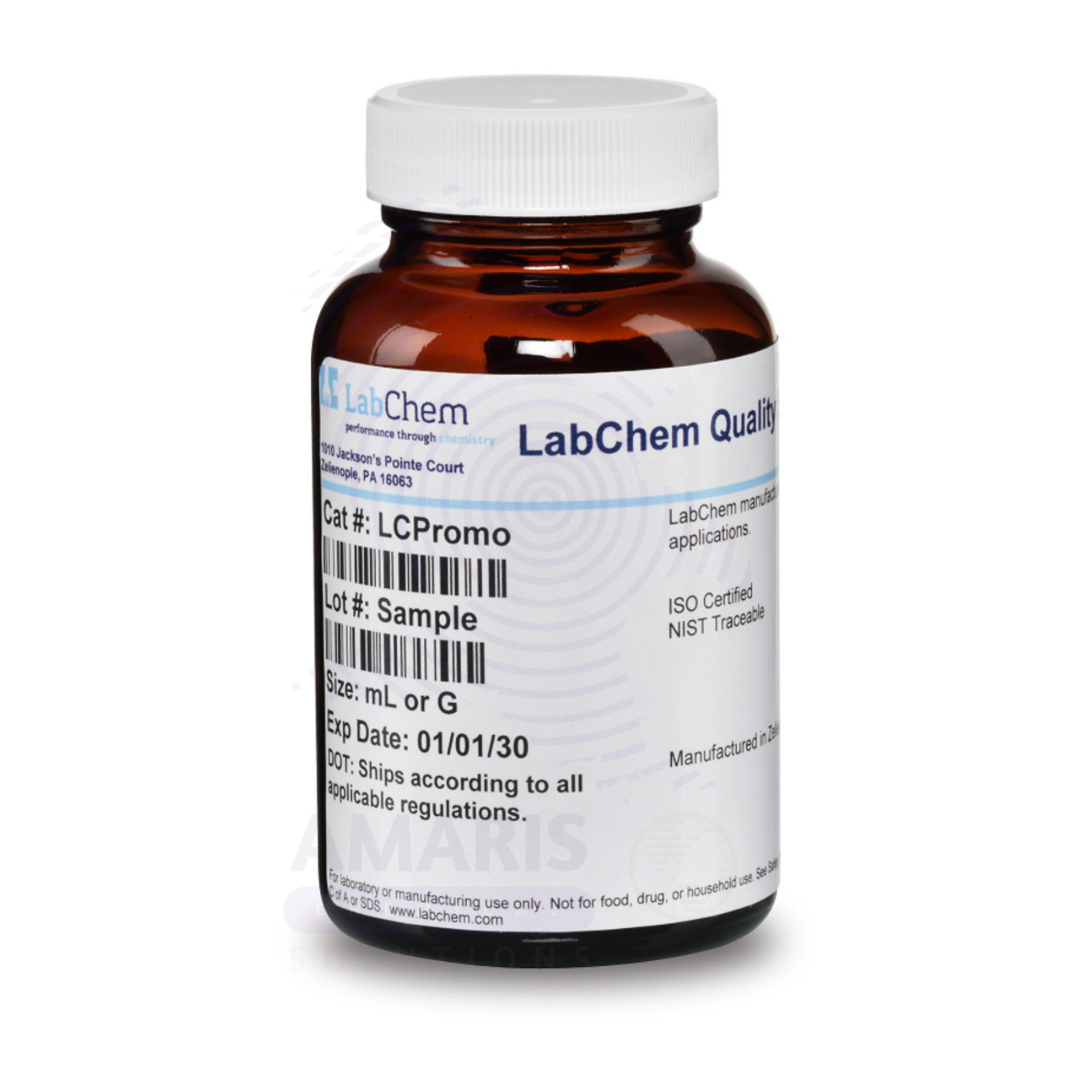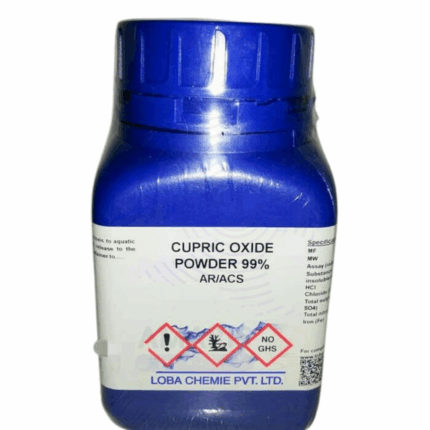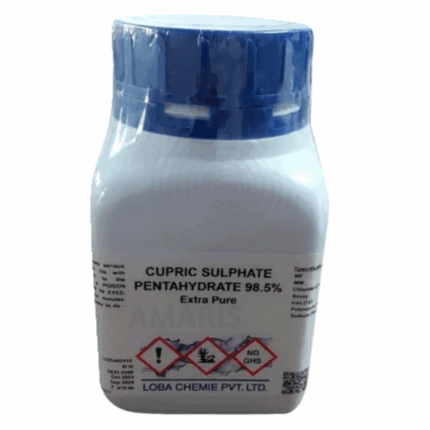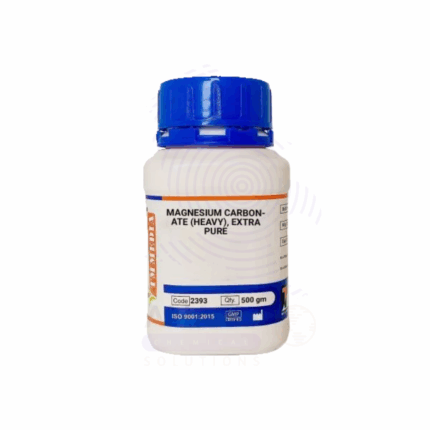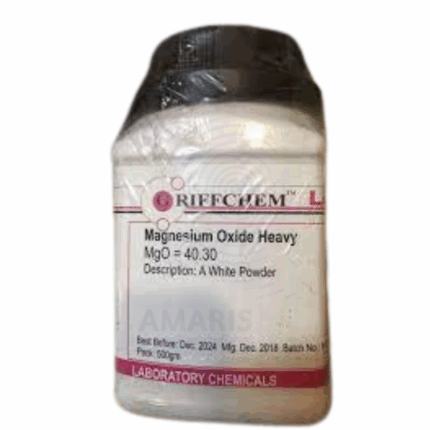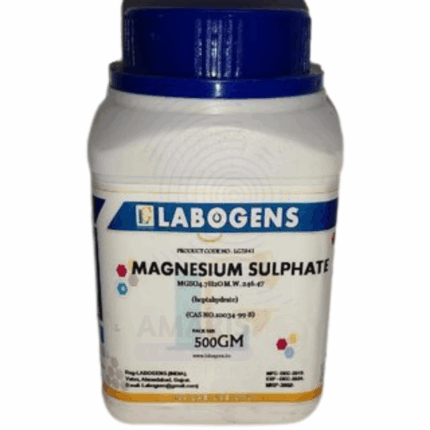

Methyl Orange Disodium Salt Extra Pure
$ 17.70 Original price was: $ 17.70.$ 17.63Current price is: $ 17.63.
Methyl Orange Disodium Salt Extra Pure is a high-purity pH indicator commonly used in titrations and analytical chemistry to determine acidity levels. It exhibits a sharp color change from red in acidic environments to yellow in alkaline conditions, typically within the pH range of 3.1 to 4.4. This disodium salt form ensures excellent solubility in water, making it especially reliable for use in aqueous solutions. Its stability and sensitivity make it ideal for laboratory applications involving strong acid–base reactions, particularly in titrations of mineral acids. Methyl Orange Disodium Salt Extra Pure is a trusted choice for consistent and accurate results in both educational and professional lab settings.
Methyl Orange Disodium Salt Extra Pure
Primary Uses
- pH Indicator in Titration – Widely used in acid-base titrations to detect endpoint, changing color in the pH range of 3.1 (red) to 4.4 (yellow).
- Analytical Reagent – Utilized in qualitative and quantitative analysis of acids and bases, especially in educational and research laboratories.
Secondary Uses
- Educational Demonstrations – Commonly used in chemistry education to visually demonstrate pH changes and titration procedures.
- Dye Component – Occasionally used in the formulation of dyes or pigments for academic demonstrations.
- Calibration of pH Meters – Sometimes used to verify pH meter performance in conjunction with buffer standards.
| PACK SIZE |
25 grams Plastic Tin |
|---|
1. Basic Identification Attributes
- Chemical Name: Methyl Orange Disodium Salt
- Synonyms: Sodium salt of Methyl Orange, Acid Orange 52, C.I. 13025
- CAS Number: 547-58-0
- Molecular Formula: C₁₄H₁₄N₃NaO₃S
- Molecular Weight: 327.33 g/mol
- Appearance: Orange-red powder
- Odor: Odorless
- Solubility: Soluble in water
- Grade: Extra Pure
- pH Indicator Range: 3.1 (red) to 4.4 (yellow)
2. Safety & Hazard Attributes
- GHS Classification:
- Not classified as hazardous under GHS in typical lab quantities, but caution is advised.
- Hazard Statements (if any):
- May cause skin or eye irritation with prolonged exposure
- Avoid inhalation of dust
- Precautionary Statements:
- P280: Wear protective gloves/protective clothing/eye protection
- P261: Avoid breathing dust
- P264: Wash hands thoroughly after handling
- Personal Protective Equipment (PPE):
- Gloves
- Safety goggles
- Lab coat
- Use under fume hood or with dust extraction if in powder form
- First Aid Measures:
- Inhalation: Move to fresh air; seek medical help if symptoms persist
- Skin Contact: Wash with soap and water
- Eye Contact: Rinse cautiously with water for several minutes
- Ingestion: Rinse mouth with water; seek medical attention if unwell
- Fire Hazards:
- Non-flammable
- Use standard extinguishing agents (CO₂, foam, dry chemical) for packaging materials
3. Storage & Handling Attributes
- Storage Conditions:
- Store in a cool, dry place
- Keep container tightly closed
- Protect from moisture and direct sunlight
- Handling Tips:
- Minimize dust generation
- Avoid contact with skin and eyes
4. Laboratory Applications
- Primary Uses:
- pH indicator in acid-base titrations
- Detects endpoint in strong acid vs. weak base titrations
- Secondary Uses:
- Teaching experiments in analytical and general chemistry
- Dyeing agent in some microbiology procedures (not for staining)
SAFETY PRECAUTIONS
Personal Protective Equipment (PPE):
- Wear a lab coat, nitrile gloves, and protective goggles.
- Use a dust mask or work in a fume hood to prevent inhalation of powder.
Handling:
- Avoid inhalation, ingestion, and contact with skin and eyes.
- Handle with care to avoid creating dust.
- Wash hands thoroughly after handling.
Storage:
- Store in a cool, dry, and well-ventilated area.
- Keep the container tightly closed and protected from moisture and light.
- Keep away from strong oxidizing agents.
FIRST AID MEASURES
Inhalation:
- Move the person to fresh air.
- Seek medical attention if symptoms such as coughing or difficulty breathing occur.
Skin Contact:
- Wash with soap and plenty of water.
- Remove contaminated clothing.
- Get medical advice if irritation or a rash appears.
Eye Contact:
- Rinse cautiously with water for several minutes.
- Remove contact lenses if present and easy to do.
- Continue rinsing and seek medical attention if irritation persists.
Ingestion:
- Rinse your mouth thoroughly with water.
- Do not induce vomiting.
- Seek medical attention immediately.
FIRE FIGHTING MEASURES
Flammability:
- Not highly flammable, but fine dust may form combustible dust-air mixtures.
Extinguishing Media:
- Use dry chemicals, CO₂, or foam.
- Water spray may be used to cool surfaces but avoid generating dust clouds.
Hazardous Combustion Products:
- May release carbon oxides, sulfur oxides, and nitrogen oxides upon combustion.
Firefighter Protection:
- Use self-contained breathing apparatus (SCBA) and wear full protective gear.


 Preservatives(food)
Preservatives(food) Flavor Enhancers
Flavor Enhancers Acidulants
Acidulants Sweeteners
Sweeteners Antioxidants
Antioxidants Colorants(food)
Colorants(food) Nutraceutical Ingredients (food)
Nutraceutical Ingredients (food) Nutrient Supplements
Nutrient Supplements Emulsifiers
Emulsifiers
 Collectors
Collectors Dust Suppressants
Dust Suppressants Explosives and Blasting Agents
Explosives and Blasting Agents Flocculants and Coagulants
Flocculants and Coagulants Frothers
Frothers Leaching Agents
Leaching Agents pH Modifiers
pH Modifiers Precious Metal Extraction Agents
Precious Metal Extraction Agents
 Antioxidants(plastic)
Antioxidants(plastic) Colorants (Pigments, Dyes)
Colorants (Pigments, Dyes) Fillers and Reinforcements
Fillers and Reinforcements Flame Retardants
Flame Retardants Monomers
Monomers Plasticizers
Plasticizers Polymerization Initiators
Polymerization Initiators Stabilizers (UV, Heat)
Stabilizers (UV, Heat)
 Antifoaming Agents
Antifoaming Agents Chelating Agents
Chelating Agents Coagulants and Flocculants
Coagulants and Flocculants Corrosion Inhibitors
Corrosion Inhibitors Disinfectants and Biocides
Disinfectants and Biocides Oxidizing Agents
Oxidizing Agents pH Adjusters
pH Adjusters Scale Inhibitors( water)
Scale Inhibitors( water)
 Antioxidants(cosmetic)
Antioxidants(cosmetic) Emollients
Emollients Fragrances and Essential Oils
Fragrances and Essential Oils Humectants
Humectants Preservatives
Preservatives Surfactants(cosmetic)
Surfactants(cosmetic) Thickeners
Thickeners UV Filters
UV Filters
 Fertilizers
Fertilizers Soil Conditioners
Soil Conditioners Plant Growth Regulators
Plant Growth Regulators Animal Feed Additives
Animal Feed Additives Biostimulants
Biostimulants Pesticides (Herbicides, Insecticides, Fungicides)
Pesticides (Herbicides, Insecticides, Fungicides)
 Active Pharmaceutical Ingredients (APIs)
Active Pharmaceutical Ingredients (APIs) Excipients
Excipients Solvents(pharmaceutical)
Solvents(pharmaceutical) Antibiotics
Antibiotics Antiseptics and Disinfectants
Antiseptics and Disinfectants Vaccine Adjuvants
Vaccine Adjuvants Nutraceutical Ingredients (pharmaceutical)
Nutraceutical Ingredients (pharmaceutical) Analgesics & Antipyretics
Analgesics & Antipyretics
 Analytical Reagents
Analytical Reagents Solvents(lab)
Solvents(lab) Chromatography Chemicals
Chromatography Chemicals Spectroscopy Reagents
Spectroscopy Reagents microbiology-and-cell-culture-reagents
microbiology-and-cell-culture-reagents Molecular Biology Reagents
Molecular Biology Reagents Biochemical Reagents
Biochemical Reagents Inorganic and Organic Standards
Inorganic and Organic Standards Laboratory Safety Chemicals
Laboratory Safety Chemicals Specialty Laboratory Chemicals(Special Laboratory Equipment)
Specialty Laboratory Chemicals(Special Laboratory Equipment)
 Demulsifiers
Demulsifiers Hydraulic Fracturing Fluids
Hydraulic Fracturing Fluids Scale Inhibitors(oil)
Scale Inhibitors(oil) Surfactants(oil)
Surfactants(oil) Drilling Fluids
Drilling Fluids
 Dyes and Pigments
Dyes and Pigments Bleaching Agents
Bleaching Agents Softening Agents
Softening Agents Finishing Agents
Finishing Agents Antistatic Agents
Antistatic Agents
 Admixtures
Admixtures Waterproofing Agents
Waterproofing Agents Sealants and Adhesives
Sealants and Adhesives Curing Compounds
Curing Compounds Concrete Repair Chemicals
Concrete Repair Chemicals Anti-Corrosion Coatings
Anti-Corrosion Coatings
 Surfactants(cleaning)
Surfactants(cleaning) Builders
Builders Enzymes
Enzymes Solvents (Cleaning)
Solvents (Cleaning) Fragrances
Fragrances
 Electronic Chemicals
Electronic Chemicals Catalysts
Catalysts Lubricants
Lubricants Photographic Chemicals
Photographic Chemicals Refrigerants
Refrigerants Automotive chemicals
Automotive chemicals Pyrotechnic Chemicals
Pyrotechnic Chemicals
 Biodegradable Surfactants
Biodegradable Surfactants Bio-based Solvents
Bio-based Solvents Renewable Polymers
Renewable Polymers Carbon Capture Chemicals
Carbon Capture Chemicals Wastewater Treatment Chemicals
Wastewater Treatment Chemicals
 Pigments
Pigments Solvents(paint)
Solvents(paint) Specialty Coatings
Specialty Coatings Binders/Resins
Binders/Resins Additives
Additives Driers
Driers Anti-Corrosion Agents
Anti-Corrosion Agents Functional Coatings
Functional Coatings Application-Specific Coatings
Application-Specific Coatings
 Fresh Herbs
Fresh Herbs Ground Spices
Ground Spices Whole Spices
Whole Spices Spice Blends
Spice Blends Dried Herbs
Dried Herbs
 Leavening Agents
Leavening Agents Dough Conditioners
Dough Conditioners Flour Treatments
Flour Treatments Fat Replacers
Fat Replacers Decoratives
Decoratives Preservatives(baking)
Preservatives(baking)
 Plasticizers & Softeners
Plasticizers & Softeners Reinforcing Agents
Reinforcing Agents Adhesion Promoters
Adhesion Promoters Vulcanizing Agents
Vulcanizing Agents Antidegradants
Antidegradants Blowing Agents
Blowing Agents Fillers & Extenders
Fillers & Extenders Accelerators & Retarders
Accelerators & Retarders